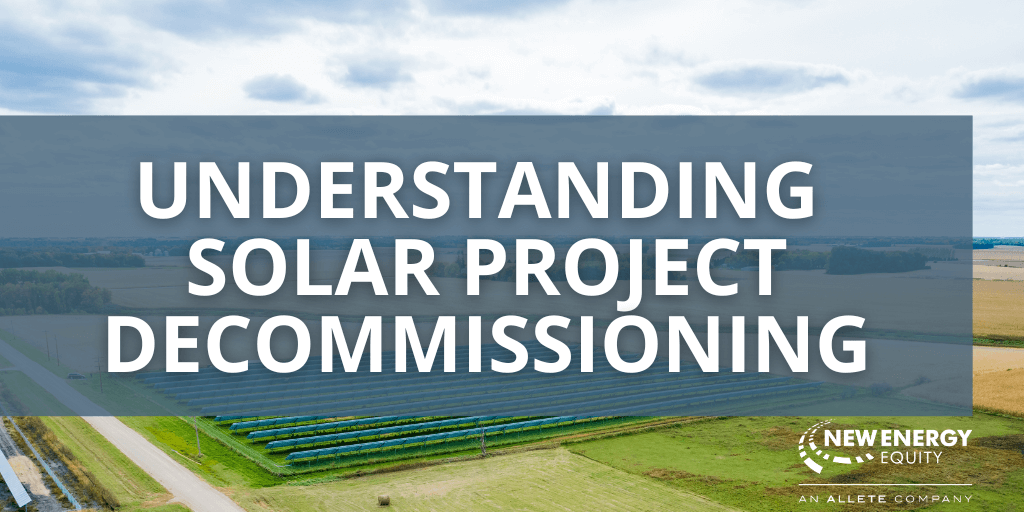New Energy Insights Blog

Understanding Solar Project Decommissioning
By: Kyle Wehnes
With the increasing pace of community and utility-scale solar adoption, solar project decommissioning is a topic gaining attention. Landowners and community stakeholders that host solar projects want to know what happens when they reach the end of their operational life. Let’s talk about what decommissioning is, what happens during the process, who is responsible, and how landowners and community stakeholders are impacted.
What is Decommissioning?
Decommissioning refers to the process of dismantling and removing solar energy infrastructure from a site, with the goal of restoring the land to its original condition or better. This is especially important to landowners hosting a solar project, as landowners want to be assured that the land can be reused at the end of a project. This process typically occurs at the conclusion of the lease term, which can range from 25-35 years.
What happens during decommissioning?
Decommissioning involves the removal, restoration, and potential repurposing of the various components of the solar system. Each component is unique, so they are all dealt with separately.
Solar panels are detached from the racking and either sold or recycled. When sold, the panels are often used in off-grid applications or electrification projects in developing countries. Glass and aluminum comprise most of a solar panel’s weight and can be easily recycled. Recycling is often done through a growing network of waste management firms that specialize in solar materials.
Racking systems used to mount the solar panels account for a large portion of the overall materials, and due to being made of either aluminum or galvanized steel, they are usually recycled or sold as scrap. Other elements of the project, such as the fencing, wire, transmitters, and mounts are also made of different metals and are recycled and reused.
Inverters and other heavy electrical equipment aren’t as simple to deal with once they are dismantled and removed. Some components are refurbished or recycled, but certain parts may need to be landfilled due to their composition.
Land restoration plays a crucial role in decommissioning, ensuring that the land returns to its original state. For instance, the racking is usually mounted quite deeply into the ground and while the goal is to remove it completely, sometimes this is impossible. In such a case, the racking posts are cut, and the holes are covered in a way that ensures the surrounding ground is fully usable. If cement was used for foundations or access roads, this is removed, and the ground is restored to its original state whether that be gravel, soil, or grass. Every part of this process is designed with the local ecosystem in mind and will vary from project to project.
Who is responsible for decommissioning?
The responsibility for decommissioning often lies with the county, which mandates the creation of a decommissioning plan and the provision of a decommissioning bond paid by the developer. This bond serves as a financial guarantee for the eventual removal of the project, with funds being released to cover costs if the company responsible ceases to exist.
Estimating the cost of decommissioning decades into the future involves considerations such as inflation, the potential resale value of components and the future cost of labor.
Most importantly, the landowner is not financially responsible for any aspect of the decommissioning process.
Other options outside of decommissioning
‘Repowering’, the act of replacing outdated system components with new ones and extending the system’s life, is emerging as an alternate option to decommissioning. Think of it as retrofitting an old car with a new engine instead of selling it and buying a brand-new model. In this scenario the lease would be extended, and the solar system would utilize the new and improved components to continue producing energy.
Conclusion
Solar project decommissioning is a multifaceted process that navigates the end-of-life phase of solar projects responsibly and sustainably. Decommissioning is just as important a part of the renewable energy process as the development and construction of a project. The thorough planning process ensures that all parties involved benefit from it. Land is restored, materials are repowered, recycled, or responsibly discarded. Landowners can reuse their land for another solar project, farming or anything else they desire.
